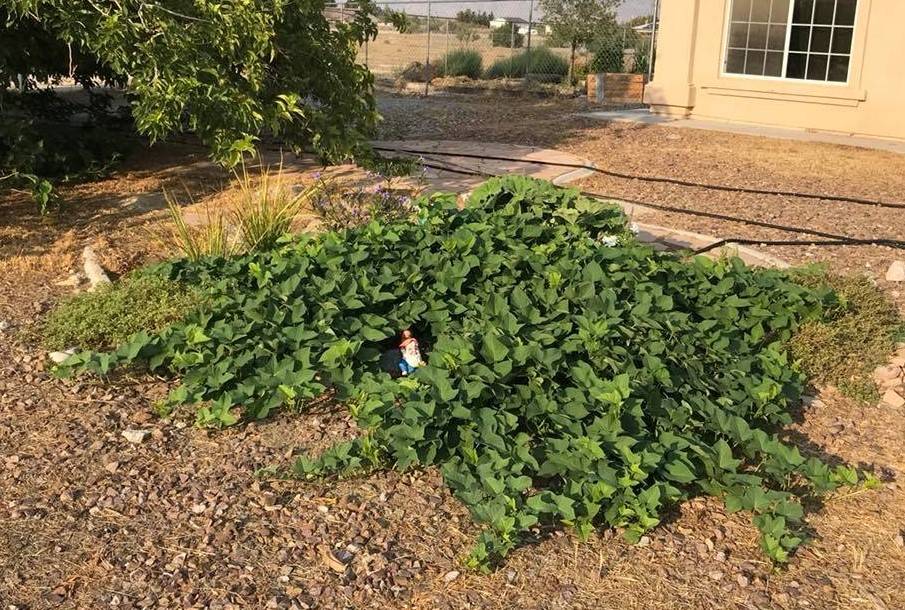In Season: My sweet potato obsession
In 1918 an H1N1 virus that would come to be called the Spanish Influenza swept the United States and the little town of Madrid, Alabama was not spared from the agony. 10-year-old Edna Register’s family was the only family in the town of 200 avoid the illness that struck down their neighbors.
Edna’s mother kept a pot cooking on the stove and filled glass jars with soup, which Edna delivered to the doorsteps of neighbors who were too ill to cook for themselves. Her father cleared a patch of land close to their home and planted sweet potatoes, which Edna, in a 2008 interview conducted by the Alabama Department of Public Health, estimated fed at least half the town.
Those who’ve conversed with me about my garden would probably tell you that I am obsessed with sweet potatoes, and they would be correct. I love them because not only are they easy to grow but they do well in our climate, and you can get so many uses from them.
Both their roots and leaves are edible. They can help break up soil compaction in our clay soils to improve the growing space for future years. If you trellis your summer crops, such as tomatoes, you can grow sweet potatoes between them, and you’ll yield twice as much produce from the space. On top of that, they make an excellent ground cover for the plants they are grown with.
How to plant sweet potatoes: You’ll need seed potatoes to get started. They are fairly easy to obtain. The first year I planted sweet potatoes I picked up a bag from the grocery store. The variety of sweet potato most commonly sold in grocery stores is called Beauregard. It has the familiar orange flesh that is often associated with sweet potatoes. The purple varieties also grow well here.
From the first week of April until mid-July you can plant sweet potatoes directly into the garden. They are a warm-weather crop and really start to thrive as we move into the heat of summer. To plant them, space whole potatoes at least 1 foot apart. Dig a hole just deep enough to cover the sweet potato. After planting, water your garden well and keep moist but not wet. Sweet potatoes will rot if they sit in wet conditions for too long.
If you are planting sweet potatoes between other seedlings in your garden, you will want to plant those a few weeks before you plant the sweet potatoes. This will give your other plants time to grow and not be shaded out by the sweet potato vines.
Caring for sweet potatoes during the growing season: Sweet potatoes are a very low-maintenance crop. You do not need to fertilize them and their pests are few in our region. If you see leaves and vines begin to wilt during the heat of summer that is likely the result of insufficient watering rather than a disease or pest.
Harvesting and storing sweet potatoes: Most varieties of sweet potato will be ready to harvest in three to four months. I tend to wait until after all my other summer crops have been harvested and the first frost has come. This is usually in early to mid-November. The frost will kill the leaves of the sweet potato, but the potatoes will survive. After the leaves die you want to harvest any sweet potatoes you still have left in the ground or they will begin to rot.
Choose a dry day for harvesting and do not water beforehand. Before digging, loosen the soil at least 1 foot in circumference around the plant to avoid injuring the tubers. To pick the sweet potatoes use a shovel or spade to gently dig them up. You want to use a gentle shaking motion as you pull. If you don’t manage to find all the tubers, worry not. You’ll probably end up with some volunteer sweet potatoes next year.
Once you have pulled the sweet potatoes from the ground use a dry brush to remove all the loose dirt. Do not wash the potatoes or get them wet. Leave the sweet potatoes in the sun for several hours. At this point you should bring them inside to cure.
Curing is an important step that will allow the sweet potatoes to store for a long period of time without rotting and improves the flavor. The easiest way that I have found to cure sweet potatoes is to store them in a long shallow cardboard box that is open on the top. These can be found at grocery stores for free. Ask the produce manager, they usually just throw them out or recycle them after they receive produce shipments.
Place your dry sweet potatoes into the boxes leaving a few inches between each potato and stack the boxes in a dark, dry, cool place up off the ground. Seed saving for next year’s planting: When harvesting your sweet potatoes, they will come up in a variety of sizes. I save the small potatoes to use for seed next year. To store the seed, I use a hole puncher to make a few holes in a paper sandwich bag. I place the small potatoes into the bag and put it on a shelf in the back of my pantry.
As spring approaches, you may notice that some of your stored sweet potatoes have started to grow slips. These can be picked off and placed into a jar of water. Change the water daily and after a few days they will start to form roots. These rooted slips can be planted out once the weather warms in early April. After the first year you should never need to buy sweet potato starts again.
Nutrient-dense sweet potatoes are the ultimate food security. You don’t need to invest in a raised bed or greatly improve our desert soil to grow them. They love our heat like few other vegetables do. Plant sweet potatoes in every nook and cranny you can think of. And you too, can feed half your neighbors.
Terri Meehan is the Founder of Southern Nevada Gardening Association a regional group. She is a garden mentor and local farmer in Pahrump. Send questions or comments to her at sonvgarden@gmail.com
















